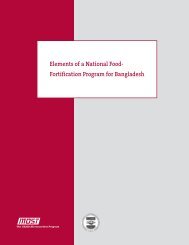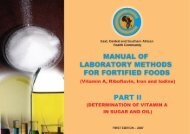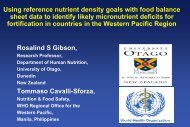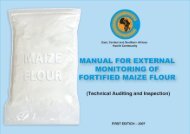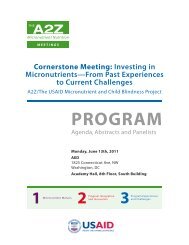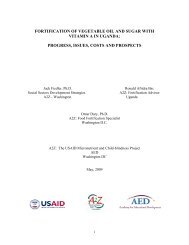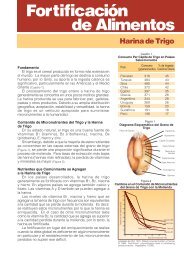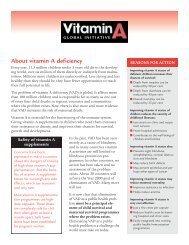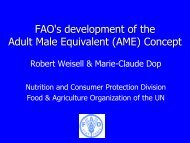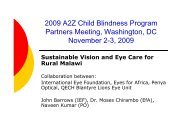manual of methods for determining micronutrients in fortified foods
manual of methods for determining micronutrients in fortified foods
manual of methods for determining micronutrients in fortified foods
Create successful ePaper yourself
Turn your PDF publications into a flip-book with our unique Google optimized e-Paper software.
− Powdered activated carbon, p.a.<br />
− Potassium chloride (KCl) p.a., mol wt. 74.56<br />
− Sodium chloride (NaCl) p.a., mol wt. 58.44<br />
− Sodium lauryl sulfate or Neutral Extran<br />
− Potassium dihydrogen phosphate (KH 2<br />
PO 4<br />
), p.a., mol wt. 136.09 g/mol.<br />
− Sodium dihydrogen phosphate (Na 2<br />
HPO 4<br />
) p.a., mol wt. 141.96<br />
− Sodium hydroxide (NaOH) p.a., mol wt. 40.0<br />
− Medium <strong>for</strong> folic acid analysis (Folic acid medium AOAC, HiMediaM126 )<br />
− Medium <strong>for</strong> stra<strong>in</strong>s ma<strong>in</strong>tenance <strong>in</strong> microbiological assays <strong>of</strong> vitam<strong>in</strong>s (Micro vitam<strong>in</strong> test<br />
cultura agar, HiMedia M132D)<br />
− Medium <strong>for</strong> stra<strong>in</strong> propagation Bra<strong>in</strong> Heart Infusion or Trypticase Soy Broth<br />
− Pancreat<strong>in</strong><br />
− Toluene (C 7<br />
H 8<br />
) p.a., mol wt. 92.14, d=0.87 g/mL<br />
VII.<br />
Solutions<br />
A. Reagents<br />
1. Hydrochloric acid-0.1N: In a 1-L volumetric flask conta<strong>in</strong><strong>in</strong>g around 800 mL distilled water, add<br />
8.3 mL concentrated hydrochloric acid. Agitate and br<strong>in</strong>g to volume with distilled water. Work <strong>in</strong><br />
a fume hood. Store <strong>in</strong> a glass conta<strong>in</strong>er <strong>in</strong> a cool dark place, separated from bases.<br />
2. Distilled water treated with activated carbon: Add 10 mg activated carbon to 1 L distilled water<br />
(picture to the left). Agitate and let settle <strong>for</strong> one day. Filter the solution through filter paper Whatman<br />
No. 1 (picture to the right). Prepare solution every time it will be used.<br />
3. Phosphates buffer-0.1M, pH=7. Weigh 9 sodium chloride, 0.2 g potassium chloride, 1.44 g<br />
Na2HPO4, 0.24 g KH2PO4 and dissolve <strong>in</strong> 500 mL distilled water treated with activated carbon.<br />
Adjust pH to 7 with KOH 4N. Transfer the solution to a 1-L volumetric flask and br<strong>in</strong>g to volume<br />
with distilled water treated with activated carbon. Prepare a fresh buffer every time. If stored,<br />
sterilize <strong>in</strong> autoclave at 121-124°C <strong>for</strong> 30 m<strong>in</strong>utes and keep <strong>in</strong> the refrigerator.<br />
4. Sterile glycer<strong>in</strong>e-15% v/v: Add 17 mL glicer<strong>in</strong>e 87% to a glass bottle with screw cap conta<strong>in</strong><strong>in</strong>g<br />
83 mL isotonic sal<strong>in</strong>e solution. Sterilize <strong>in</strong> autoclave at 121-123°C <strong>for</strong> 30 m<strong>in</strong>utes and cool down<br />
to room temperature. Prepare a fresh solution every work<strong>in</strong>g day.<br />
5. Ammonium hydroxide-(2+3) around 40% v/v: In a 100-mL volumetric flask conta<strong>in</strong><strong>in</strong>g around<br />
30 mL distilled water, add 40 mL concentrated ammonia (NH3) and br<strong>in</strong>g to volume with distilled<br />
water. Store <strong>in</strong> a plastic conta<strong>in</strong>er, separated from acid solutions. Solution is stable <strong>in</strong>def<strong>in</strong>itely.<br />
- 52 -





